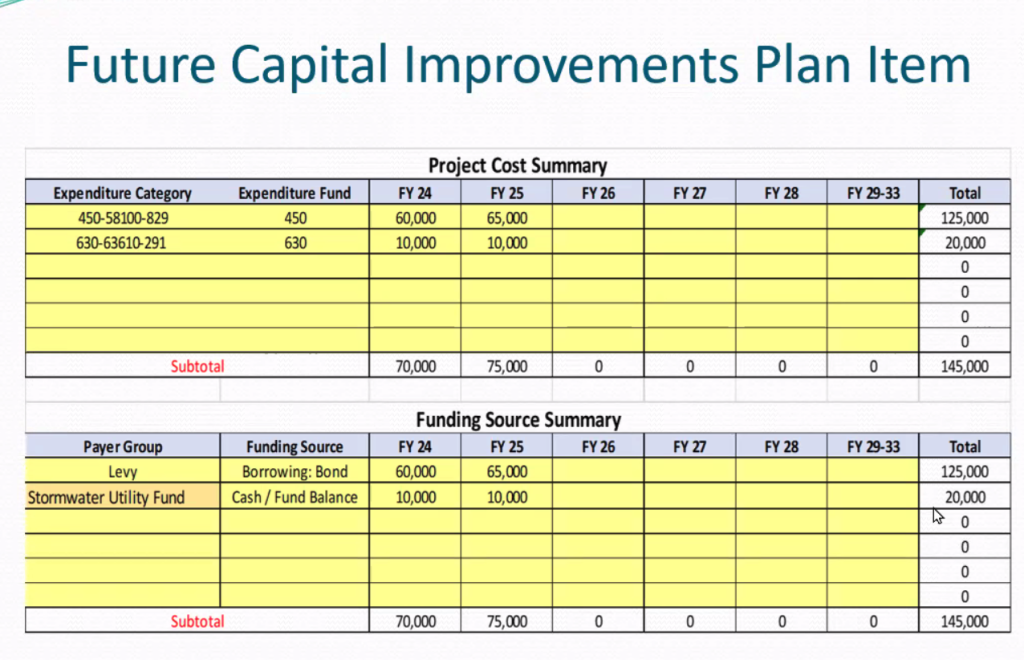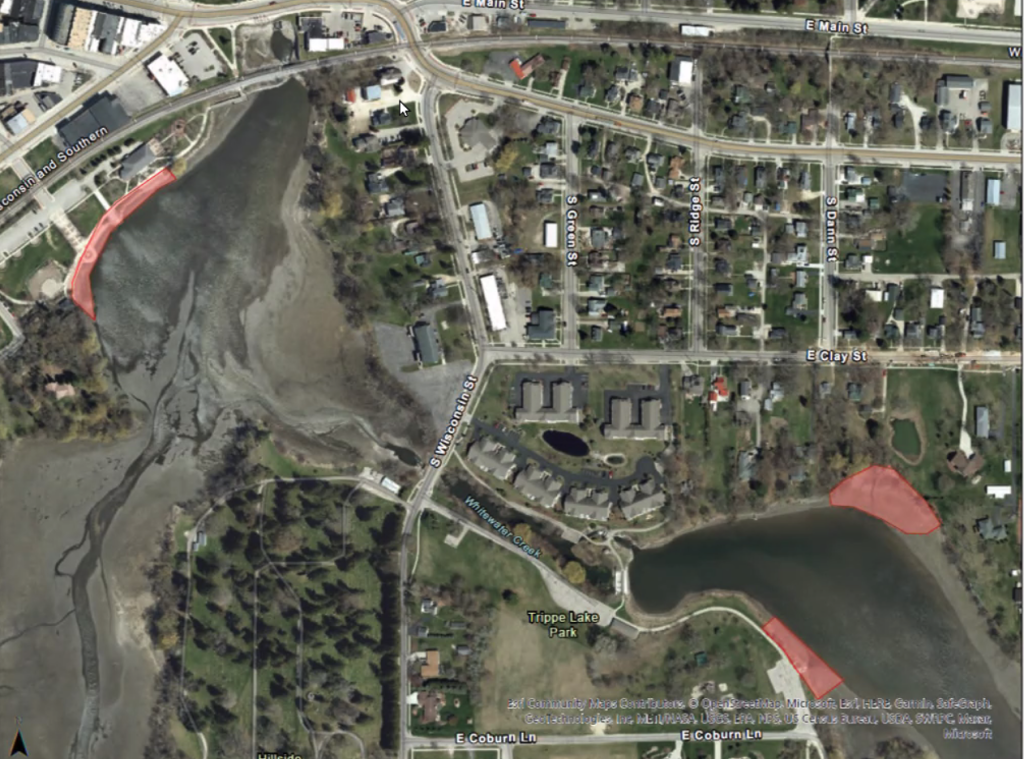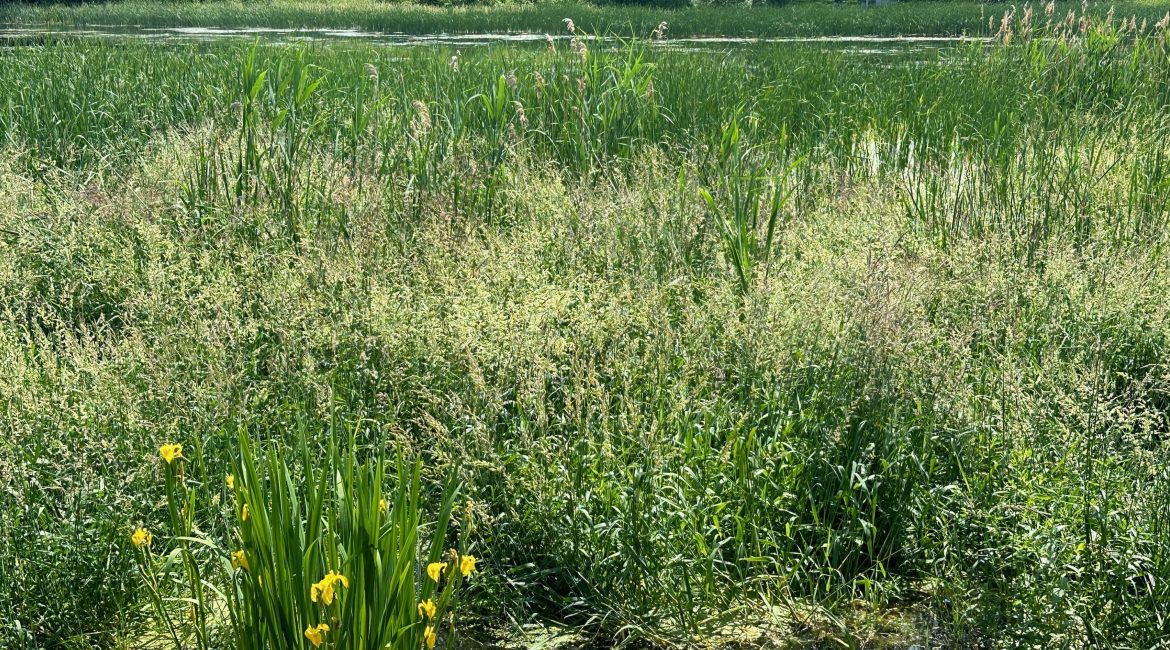Editor’s note: The spelling of Trippe lake has been updated. An earlier spelling omitted the letter “e.” Fort Atkinson Online regrets the error.
By Kim McDarison
The Whitewater Common Council Tuesday, after hearing proposals from city staff for cattail abatement on two of the community’s lakes, opted to postpone further discussion before approving a contract, pending the development by staff of further information.
Whitewater City Manager John Weidl said staff would return before council in one month with information about options beyond vegetation cutting and root ball removal through the process of dredging.
During Tuesday’s meeting, several city residents suggested the city explore purchasing weed-cutting equipment, employing herbicides, raising lake water levels, and forming a lakes management association.
Cutting or dredging
Discussion began with two presentations offered by Whitewater Parks and Recreation Director Eric Boettcher.
Offered information during “staff reports,” Boettcher shared an update on the city’s two lakes — Cravath and Trippe — and the ongoing restoration project begun by the city in 2019. In May, during an interview with Fort Atkinson Online, Boettcher estimated some $1.5 million had been spent on the project.
He noted that Wisconsin Department of Natural Resources (DNR) biologist Heidi Bunk, who has been working with the city over the course of the project, visited the lakes in May to access the project’s progress.
Bunk offered suggestions for cattail abatement, he said, focusing specifically on vegetation growing along the lakes’ shorelines.
Aided by slides, Boettcher said each of two options for further cattail abatement came with “benefits” and “drawbacks.”
Among options, Boettcher proposed cutting shoreline cattails, which, he said, was relatively cost-effective, but came with the “negative aspect” that the vegetation could grow back, as compared with a second option, that of root ball removal, which was viewed by the DNR as dredging. The dredging process, he said, was less cost effective, but offered “more permanence,” regarding longterm abatement.
According to Boettcher, the DNR is the agency that makes decisions about how much vegetation can be removed from waterbodies.
“So we are looking at doing pathways along the park area, and clearing out some of that vegetation,” Boettcher said.
A slide showed areas marked along the shoreline in front of Cravath Lakefront and Trippe Lakefront parks and the Clay Street Nature Area which could be cut or dredged, Boettcher said, adding that two years remain on a previously approved DNR five-year dredging permit, which would allow the city to engage in further dredging activities without making a new application for the next two years.
The city had obtained estimates from two vendors regarding both cutting and dredging of the proposed areas, he said.
Additionally, he said, the city’s staff explored employing dredging, along with its associated costs, with such activity taking place several times, potentially in 2023, and 2024, and, would the city opt to apply for an additional dredging permit, again in 2025.
A slide, showing costs project over the remaining two years of the city’s dredging permit, indicated that the city, through dredging, could incur costs of $70,000 in 2024, and $75,000 in 2025.
Funding sources for the project were identified as coming through a borrowing, in the amounts of $60,000 in 2024, and $65,000 in 2025. An additional $10,000 in each year was achieved through use of dollars within the city’s stormwater utility fund.
Following Boettcher’s staff report, council member David Stone noted that within his packet, he read a statement coming from the DNR agent, saying the water was cleaner and clearer within the lakes’ centers.
“I think the public assessment is different,” he said.
Councilwoman Jill Gerber queried Boettcher about a tour of the lakes’ shorelines which had been requested by council at a previous meeting.
Boettcher said staff was working on scheduling the requested tour, which, he said, he anticipated would take place sometime after the Fourth of July.
Councilwoman Brienne Brown asked if, after the city dredged, if that plan was approved, there was a plan to replace the removed vegetation with “something else.”
“Anybody with gardens knows that something will be back. It may not be that (cattails), but something will show up,” she said.
Boettcher said the city could explore the possibility.
Brown expressed concern that the city was “picking the same areas,” that were previously dredged.
She cited vegetation growing farther away from the shorelines, asking: “Are you eventually planning on hitting across there or are we just going to contain the area where we originally dredged?”
Boettcher said the city was focusing on the shorelines.
He said the areas indicated on his slides were not areas that had been previously dredged.
Gerber asked if the city had plans to “hit the green areas in the middle of the lake.”
Boettcher responded by saying that if the water level in the lake “comes up high enough,” then some of the vegetation would die off.
“That’s going to take time,” he said.
Council President Jim Allen asked about the use of herbicide.
Within a memo to council, Boettcher wrote: “The vegetation along the shoreline will continue to die back and the timing of this will depend on future weather conditions.”
He continued: “Recommendations given to us to help control and speed up the process are to allow us to cut pathways to the open water. Although we are not able to remove all of the cattails, we are able to create pathways from around the boat launch areas and in designated areas in front of the parks. Residents who live along the lake are also able to perform these types of remedies along their shoreline.”
Staff makes recommendation to dredge
In a second memo and presentation, Boettcher retuned to the podium requesting council to take action by approving a proposed lake dredging contract.
Within his second memo, Boettcher wrote that the focus of the lakes project has shifted to address the shoreline of the lakes, adding that the vegetation along the shoreline is anticipated to recede. However, he wrote, additional cutting or dredging will help facilitate the outcome.
Boettcher presented quotes for vegetation cutting and root ball removal or dredging received by two vendors: Eco-Waterways and Field and Stream Restoration.
Looking at the less expensive option — cutting — Boettcher said a cost estimate provided by Eco Waterways to perform cutting of vegetation in the three areas earlier indicated on a slide — in front of the Cravath Lakefront Park concrete platform, the Trippe Lakefront Park shoreline and an area of shoreline at the Clay Street Nature Area — was $29,750.
An itemization of services provided by the company showed an estimate of $22,400 for weed cutting based on the city’s map of Cravath Lake and an additional $7,350 based on the map of Tripp Lake.
Field and Stream Restoration provided an estimate of $46,000 for “cutting and restoration.”
For dredging services, based on the maps provided by the city, Eco-Waterways estimated the project at between $62,000 and $74,000.
According to Boettcher, dredging requires that work is publicly bid, with work perhaps taking place as early as late summer or early fall.
In addition, Boettcher noted that the city has $25,000 available in its lakes project budget, pointing again to options to obtain funding for the project through borrowing and stormwater unity funds.
A slide noted that borrowing for the project, if approved, would be supported through the city’s tax levy.
Addressing council after the presentation, Weidl said: “I guess the biggest thing staff is looking for guidance on is the cutting, it’s less expensive and you can get more volume done, but it is highly likely that all of those cattails will be back the following year. The dredging is more expensive and you get less volume per year. It removes the root ball and the vegetation, and the likelihood is high it will not return that year, and you can make progressive gains year after year. So it comes down to two things: What are you looking for in terms of immediate impact, and then the money, because the dredging is significantly more expensive. Not that we can’t figure that out.”
Councilman Neil Hicks said he was in favor of dredging the visible areas of shoreline in front of the parks, as indicated on the slide.
“It’s going to cost us more, but that also gives us the rest of the year to enjoy that park, you know, fireworks and shows and whatnot,” he said.
He expressed an interest in learning more about combining activities, such as cutting and applying herbicide, in future years.
“But I’d say, at least for the first year, while we still have permits available, my opinion is we dredge it and remove it completely for longevity,” Hicks said.
Gerber focused again on the areas identified for cutting or dredging.
“I guess I’m not understanding why we would spend money to cut the cattails if they are all going to grow back. Is it just for aesthetics? Or is there another purpose to this?” Gerber asked.
Said Boettcher: “So the cutting of the cattails, if it’s in deep enough water, they shouldn’t come back, but when I talked with Eco Waterways and Field and Stream, and then we add the dredging permit, I think that’s why we are looking at doing the dredging. Because it’s more permanent. I mean if you cut the vegetation, the vegetation along the shore is going to grow back. The vegetation farther out may not. But by dredging, you are giving yourself the best chance to eliminate it.”
Council member Lisa Dawsey Smith asked if efforts to raise the water level had been made.
Weidl said it was a good question.
Public comments
From the podium and during public comments, Whitewater resident Geoff Hale said the lakes were “probably the biggest asset that we’ve got,” adding: “Right now, you are looking at ‘Grand Marsh Upper’ and ‘Grand Marsh Lower.’”
While he said he believed “some phenomenal people” worked at the DNR, he also described the department as “one of the most despised agencies in the state of Wisconsin.
“They put every roadblock in place for us not to do this right the first time. (They) wouldn’t allow a bulldozer to go in there and just heave up, I mean acres and acres of dirt into two or three islands, which would have probably cost one-third of what we paid, the $1.3 million, to do, and now you’ve got nothing but vegetation that’s growing everywhere.”
He called the city’s lake project “systematic poor planning,” which, he said, “has created a monstrous floating bog on both the upper lake and the lower lake.”
He suggested that the city might explore purchasing a weed cutter, rather than “a Band-Aid for some small park areas.”
He said another area resident had researched the cost of weed cutting equipment, citing $65,000 as the arrived-upon figure.
Another commenter noted that he and his wife arrived in Whitewater six years ago, and had the benefit of enjoying the lake behind their home for three years.
The loss of the lake “does tear me up,” he said, further citing his opinion that the lake’s current condition contributes to the loss of tourism dollars.
“You need an attractive town to attract people,” he said.
Another commenter said he had contacted several governmental bodies, including the DNR, the city and Walworth County, and he’d come up empty trying to learn who controlled water levels on Trippe and Cravath lakes.
“There’s water going into Cravath Lake 365 (days) a year, it doesn’t matter that there’s been a little bit of a drought. That level can be lifted; the level can be brought up,” he said.
Yet another resident told those in attendance that he believed the DNR had “totally dropped the ball,” by allowing the lakes to remain drained for two years. He saw a missed opportunity for the use of herbicide while the lakes were drained, he said, calling the decision “a catastrophic mistake.”
He called the DNR representative working with the city “uncooperative.”
The commenter said he held permits for dredging, cutting and herbicide application for his own property and would be willing to help other landowners undertake the process if they wanted to apply for permits from the DNR.
He also advocated for the formation of a lakes association.
Following comments made by members of the public, Allen said that he was not sure that the council was ready to decide about a remedy for cattails. He thought the council should learn more from the DNR about “spray versus cutting.”
He also was interested in learning more about water levels and different vegetation cutting machinery, he said.
Said Hicks: “I shouldn’t ask, but I’m going to: Do we know what the fine would be to just go and remove everything along the shore?”
Allen responded by saying: “next question.”
Stone also expressed an interest in learning more about weed cutters.
Said Brown: “My biggest problem is that, so far, the DNR has told us a lot of things like, well, if the weather does this, or if the weather does that, we don’t know what’s going to happen. And that’s exactly what happened to us. We weren’t able to get things done except during certain weather; we weren’t able to get burns done at a certain period of time. We can’t control the weather, and I feel like we are going to keep throwing money at this, and, most of the time, we are going to be disappointed.
“That’s what really concerns me is that we are going to keep trying everything and it’s still going to want to become a wetlands because that’s what it is. Why are we not even considering how to make the wetlands look prettier? Like a Japanese garden?”
Hale expressed frustration with the comment, saying: “She (Brown) wants to turn it into a flower garden.”
Brown responded, saying: “No, no, I’m saying, let’s spend money, but I’m sick and tired of people getting mad at us for spending money because we spent money wrong, when half the time we are spending money the way people told us was the best way, given the projected weather.”
Also among speakers was former council member Carol McCormick, who served on council while the dredging process and lake restoration work was undertaken. McCormick opted against making a run in April.
She described herself as a 20-year resident of the lake.
Of Boettcher’s oversight of the project, she said, he had done “the best he could with the advice he got.”
Of council’s decision-making, she said: “We got the advice from the DNR; we did what they said we had to do.
“The result was not what we had thought,” she added.
She said she and others “have spent thousands of dollars dredging their property” and I have no access to the main channel now. I am land locked.”
She, too, advocated for a lakes management association.
Looking ahead, she said, she anticipated that “the whole city is going to have to contribute to this project. We have already invested $1.3 million, and, she said, she believed that more money will be “trickling, down the line, too.
“I thought we had a light at the end of the tunnel and obviously, that light is shutting down right now,” she said.
Weidl said staff would return before council in a month with more information.
Council opted to postpone further discussion until more information could be developed by staff.
An earlier story about cattail abatement as described in an interview by Weidl and Boettcher is here: https://fortatkinsononline.com/lake-restoration-project-continues-with-cattail-abatement-plans-city-officials-say/.

A chart, provided as one of several slides Tuesday by Whitewater Parks and Recreation Director Eric Boettcher, shows a “project costs summary,” for proposed dredging in specific areas along the shores of Cravath and Tripp lakes.

A color-coded graphic shows areas that Whitewater city staff has proposed for dredging over a three-year period. Offering an explanation of the graphic, Whitewater City Manager John Weidl, on Tuesday, said the colors — blue, red, and green — represent, in that order, proposed dredging areas to be completed in 2023, 2024 and 2025. The city’s dredging permit allows the city to dredge through 2024. To complete the areas designed in green, he said, the city would need to apply for an additional permit.

A map, presented by Whitewater Parks and Recreation Director Eric Boettcher, to the city’s common council Tuesday, shows areas city staff has proposed for additional dredging. A decision by council has been postponed until next month. Areas indicate shoreline in front of Cravath Lakefront Park, the full area of which is proposed to undergo dredging over a course of three years, at left, and areas on Trippe Lake, at right, in front of Trippe Lake Park and the Clay Street Nature Area. Both areas are proposed to undergo addition dredging as early as this year.

A variety of vegetation protrudes from the lakebed as viewed recently from the shoreline of Cravath Lakefront Park, Whitewater. Contributed photo.
This post has already been read 3634 times!

Please spell Trippe Lake correctly!
It’s named after Whitewater founder.
Thank You!
=Mark Dorn
The Village at Trippe Lake Whitewater WI
Spelled “Tripp” and “Trippe” within city documents. I will note the correction. Thank you for pointing it out. K